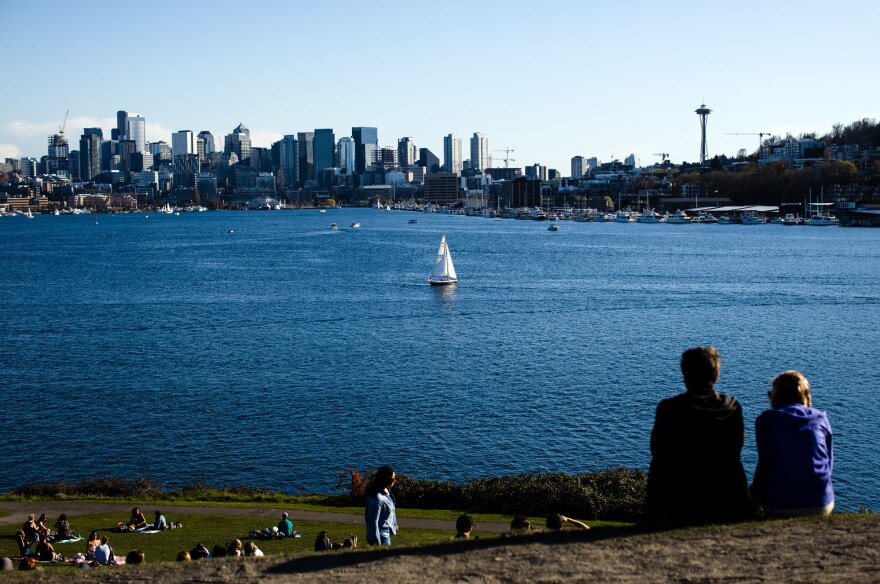There’s a key weather battle that plays out every summer. It determines how warm (or hot) conditions can get in the Puget Sound region. It’s the tug of war between onshore and offshore flow, says KNKX weather expert Cilff Mass.
“Ninety percent of understanding our weather — and in forecasting — is onshore versus offshore flow, during the warm season,” Mass said.
“It’s really quite simple. When we have onshore flow off of the cool Pacific, which is only about 50 degrees, we tend to be cool and cloudy and only a little bit of light rain.” This is what many people think of as typical Puget Sound weather.
But this week, offshore flow has been the victor. This is wind that comes from the east and heads toward the ocean — bringing warm, dry air with it that warms even more as it sinks and compresses on its way down the mountains. And it’s the root cause of the mid-May heat wave we’ve been experiencing this week, with temperatures in the upper 70s and low 80s.
“Today we’re going to get into the lower 80s again,” Mass said Friday morning. “Full sun – really nice day.”
He says Saturday will bring similar conditions, with the mercury hitting 82-84 degrees.
MAY HEAT WAVES ‘QUITE COMMON’
While the sunny skies and sandal weather might feel unseasonably warm, Mass says mid-May heat waves actually happen a lot.
“It’s quite common. In fact, you look (back at) previous years, we often get a heat wave sometime in the middle of May,” Mass said. “The sun is getting strong and so if we get a period of offshore flow — and we often do — that produces a warm spike, sometime in the middle of the month.”
But he says later in the month, high pressure tends to build in the eastern Pacific, there’s more onshore flow and that tends to cool things down and bring us the typical month of low clouds, known by many as June Gloom.
We’re not quite there yet this weekend, but Mass says starting Sunday, there will be a transition away from the current heat wave and dry conditions.
‘RADICALLY DIFFERENT’ WEATHER NEXT WEEK
Late Saturday, Mass says the big shift begins.
“Marine air is going to start surging in — in fact, I expect Saturday to be a little cooler on the coast,” he said.
Throughout the region, he says — as that offshore flow starts winning the battle again — clouds will start forming sometime later in the day on Saturday. And the wind will start picking up, coming from the ocean.
“And because of that we’re going to get a weak onshore push of marine air Saturday night into Sunday morning," Mass said. "So Sunday should be a very different day."
He expects low clouds and cooler temperatures, probably around 70-72. The clouds may break up in the afternoon, but he expects the lower temperatures to persist.
“So definitely a cooler day for Mother’s Day,” Mass said.
He doesn’t expect a lot of rain Sunday. But that will shift as temperatures gradually drop back into the 60s. And then late Tuesday into Wednesday, Mass says there will be a major change.
“We are going to transition to a radically different weather pattern," Mass said. "We’re going to go from warm and dry to cool and wet. And I am expecting substantial rain." He says it starts late Tuesday and will continue at least for the rest of the week.
“In fact, I think the second half of the month is going to be cool and wet. So — enjoy the sun. It’s going to be going away pretty soon.”
ANOTHER 'SMOKEMAGEDDON' UNLIKELY
One of the most common questions Mass has been getting lately is whether people in the greater Puget Sound region should expect smokey air from wildfires to once again foul their summer plans. For two years running, in August 2017 and 2018, the air pollution from smoke has been as bad or worse than Beijing's.
Despite a dry start to the year and the probability of a tough wildfire season, Mass says, another “Smokemageddon” is not a foregone conclusion.
“I would think the chances are against that,” Mass said.
He notes it takes more than wildfires to blanket faraway areas in smoke. “To get the really dense smoke at low levels in Seattle, is extremely hard,” he said.
It takes fires that are close enough — on the top or a near side of the Cascade Mountains — as well as strong easterly flow that directs the smoke they produce into Western Washington. “To get all of those things happening at the same time: the fire is close, the perfect winds — all that — is pretty unlikely,” Mass said.
He notes in 2015, Washington had an extremely active fire season with huge fires, but no big smoke storms on the west side.
“So it’s possible — we could have another really smokey period, but I think the chances are against getting that really dense smoke like we had last August,” he said.
To hear the full conversation, click on the "play" icon at the top of this post.
Weather with Cliff Mass airs at 9:02 a.m. Friday, right after BirdNote, and twice on Friday afternoons during All Things Considered. The feature is hosted by KNKX environment reporter Bellamy Pailthorp. Cliff Mass is a University of Washington professor of atmospheric sciences, a renowned Seattle weather prognosticator, and a popular weather blogger. You can also subscribe to podcasts of Weather with Cliff Mass shows, via iTunes or Google Play.



